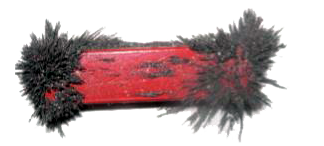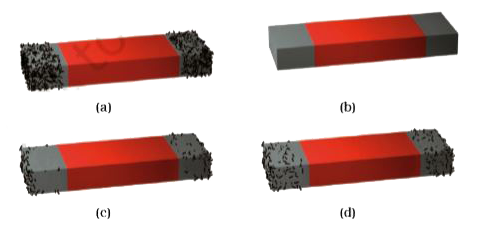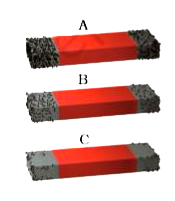A bar magnet is immersed in a heap of iron filings and pulled out. The amount of iron filling clinging to the
North pole is almost equal to the south pole.
North pole is much more than the south pole
North pole is much less than the south pole
Magnet will be same all along its length
The correct Answer is:A
To solve the question regarding the amount of iron filings clinging to a bar magnet when it is pulled out of a heap of iron filings, we can follow these steps:
1. Understanding the Magnet: A bar magnet has two poles: the North Pole and the South Pole. Each pole has a magnetic field that attracts magnetic materials, such as iron filings.
2. Immersion in Iron Filings: When the bar magnet is immersed in a heap of iron filings, the filings will align themselves along the magnetic field lines and will cling to the magnet. This is due to the magnetic attraction exerted by both poles of the magnet.
3. Pulling Out the Magnet: When the magnet is pulled out, the iron filings that were attracted to it will cling to the magnet. The amount of filings that cling to the magnet will depend on the strength of the magnetic field at each pole.
4. Comparing the Clinging Amounts: The strength of the magnetic field is generally similar at both the North and South Poles of a bar magnet. Therefore, the amount of iron filings clinging to the North Pole should be approximately equal to the amount clinging to the South Pole.
5. Analyzing the Options:
- Option A: North Pole is almost equal to the South Pole - This is likely correct since both poles have similar magnetic strength.
- Option B: North Pole is much more than the South Pole - This is incorrect as it implies a difference in magnetic strength.
- Option C: North Pole is much less than the South Pole - This is also incorrect for the same reason as Option B.
- Option D: Magnet will be the same all along its length - This is incorrect because the magnetic strength is concentrated at the poles.
6. Conclusion: Based on the analysis, the correct answer is Option A, which states that the amount of iron filings clinging to the North Pole is almost equal to that clinging to the South Pole.
Final Answer:
The correct option is Option A: North Pole is almost equal to the South Pole.
- Option A: North Pole is almost equal to the South Pole - This is likely correct since both poles have similar magnetic strength.
- Option B: North Pole is much more than the South Pole - This is incorrect as it implies a difference in magnetic strength.
- Option C: North Pole is much less than the South Pole - This is also incorrect for the same reason as Option B.
- Option D: Magnet will be the same all along its length - This is incorrect because the magnetic strength is concentrated at the poles.
The correct option is Option A: North Pole is almost equal to the South Pole.
Topper's Solved these Questions
- FUN WITH MAGNETSBOOK - NCERT EXEMPLARCHAPTER - FUN WITH MAGNETSEXERCISE - VERY SHORT ANSWER QUESTIONS
5 Videos
- FUN WITH MAGNETSBOOK - NCERT EXEMPLARCHAPTER - FUN WITH MAGNETSEXERCISE - SHORT ANSWER QUESTIONS
4 Videos
- ELECTRICITY AND CIRCUITSBOOK - NCERT EXEMPLARCHAPTER - ELECTRICITY AND CIRCUITSEXERCISE - LONG ANSWER QUESTIONS
4 Videos
- LIGHTBOOK - NCERT EXEMPLARCHAPTER - LIGHTEXERCISE - LONG ANSWER QUESTIONS
3 Videos
Similar Questions
Boojho dipped a bar magnet in a heap of iron filings and pulled it out. He found that iron filings got stuck to the magnet as shown in Fig. 13.4.
(i) Which regions of the magnet have more iron filings sticking to it?
(ii)What are these regions called?

View SolutionFour identical iron bars were dipped in a heap of iron filings one by one. Fig. 13.5 shows the amount of iron filings sticking to each of them.

(a) Which of the iron bar is likely to be the strongest magnet?
(b)Which of the iron bars is not a magnet? Justify your answer.
View Solution
Knowledge Check
The pattern of iron filings suggests that the
Amagnet has only one poleBmagnet has two polesCmagnet Is a magnetic dipoleDBoth (2) and (3)
A bar magnet is dipped in a leap of small iron filings. It is observed that a cluster of iron filings stick to the ends A and B while there is practically no iron filing stick to its central region.
Answer the following questions
The central region are called
View SolutionA bar magnet is dipped in a leap of small iron filings. It is observed that a cluster of iron filings stick to the ends A and B while there is practically no iron filing stick to its central region.
Answer the following questions
End A is called
View SolutionThree magnets A, B and C were dipped one by one in a heap of iron filing. Fig. 13.3 shows the amount of the iron filing sticking to them.

The strength of these magnets will be
View SolutionA piece AB of the magnetite is dipped in a leap of small iron filings. It is observed that a cluster of iron filings stick to the ends A and B while there is practically no iron filing stick to its central region.
Answer the following questions
End B is called
View SolutionA piece AB of the magnetitie is dipped in a leap of small iron filings. It is observed that a cluster of iron filings stick to the ends A and B while there is practically no iron filing stick to its central region.
The central region or called
View SolutionA piece AB of the magnetitie is dipped in a leap of small iron filings. It is observed that a cluster of iron filings stick to the ends A and B while there is practically no iron filing stick to its central region.
End A is called
View SolutionA piece AB of the magnetitie is dipped in a leap of small iron filings. It is observed that a cluster of iron filings stick to the ends A and B while there is practically no iron filing stick to its central region.
End B is called
View Solution
